
Java is an island of Indonesia, bordered by the Indian Ocean on the south and the Java Sea on the north. With a population of over 148 million or 152 million, Java constitutes 56.1 percent of the Indonesian population and is the world's most-populous island. The Indonesian capital city, Jakarta, is on its northwestern coast. Much of the well-known part of Indonesian history took place on Java. It was the centre of powerful Hindu-Buddhist empires, the Islamic sultanates, and the core of the colonial Dutch East Indies. Java was also the center of the Indonesian struggle for independence during the 1930s and 1940s. Java dominates Indonesia politically, economically and culturally. Four of Indonesia's eight UNESCO world heritage sites are located in Java: Ujung Kulon National Park, Borobudur Temple, Prambanan Temple, and Sangiran Early Man Site.

Gamelan is the traditional ensemble music of the Javanese, Sundanese, and Balinese peoples of Indonesia, made up predominantly of percussive instruments. The most common instruments used are metallophones played by mallets and a set of hand-played drums called kendhang which register the beat. The kemanak and gangsa are commonly used gamelan instruments in Java. Other instruments include xylophones, bamboo flutes, a bowed instrument called a rebab, siter, and even vocalists named sindhen (Female) or Gerong (Male).

The Javanese people are an ethnic group native to the Indonesian island of Java. With approximately 100 million people, they form the largest ethnic group in Indonesia. They are predominantly located in the central to eastern parts of the island. There are also significant numbers of people of Javanese descent in most provinces of Indonesia, Malaysia, Singapore, Suriname, Egypt, Saudi Arabia, and the Netherlands.
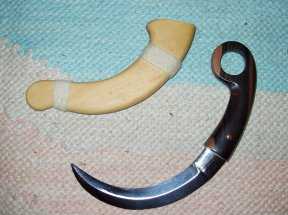
The karambit or kerambit, kurambik or karambiak is a small Indonesian curved knife resembling a claw from Minangkabau people of West Sumatra.

The kris or keris in Indonesian languages, is an Indonesian asymmetrical dagger with distinctive blade-patterning achieved through alternating laminations of iron and nickelous iron (pamor). The kris is famous for its distinctive wavy blade, although many have straight blades as well, and is one of the weapons commonly used in then pencak silat martial art native the Indonesia. Kris have been produced in many regions of Indonesia for centuries, but nowhere—although the island of Bali comes close—is the kris so embedded in a mutually-connected whole of ritual prescriptions and acts, ceremonies, mythical backgrounds and epic poetry as in Central Java. Within Indonesia the kris is commonly associated with Javanese culture, although other ethnicities are familiar with the weapon as part of their culture, such as the Balinese, Sundanese, Malay, Madurese, Banjar, Buginese, and Makassar people. Abroad, the kris is considered as a cultural symbol of Indonesia.
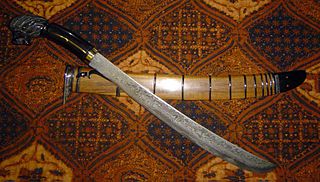
A golok is a cutting tool, similar to a machete, that comes in many variations and is found throughout the Indonesian archipelago. It is used as an agricultural tool as well as a weapon. The word golok is used in Indonesia and Malaysia and in the Philippines. Both in Malaysia and in Indonesia, the term is usually interchangeable with the longer and broader parang. In the Sundanese region of West Java it is known as bedog.

A kalis is a type of double-edged Filipino sword, often with a "wavy" section, similar to a keris. Just like the keris, the kalis's double-edged blade can be used for both cutting and thrusting; except that the kalis is much larger than most keris, making it a sword rather than a dagger.

Pencak silat is an umbrella term for a class of related Indonesian martial arts. In neighbouring countries, the term usually refers to professional competitive silat. It is a full-body fighting form incorporating strikes, grappling and throwing in addition to weaponry. Every part of the body is used and subject to attack. Pencak silat was practiced not only for physical defense but also for psychological ends.

Masjid Agung Demak is one of the oldest mosques in Indonesia, located in the center town of Demak, Central Java, Indonesia. The mosque is believed to be built by the Wali Songo with the most prominent figure Sunan Kalijaga, during the first Demak Sultanate ruler, Raden Patah during the 15th century.

The kujang is a blade weapon native to the Sundanese people of West Java, Indonesia. The earliest kujang made is from around the 8th or 9th century. It is forged out of iron, steel and pattern welding steel with a length of approximately 20–25 cm and weighs about 300 grams. According to Sanghyang siksakanda ng karesian canto XVII, the kujang was the weapon of farmers and has its roots in agricultural use. It is thought to have originated from its predecessor, a kudi. The kujang is one of the traditional weapons in the Sundanese school of pencak silat. The kujang, like the keris, is a blade of sentimental and spiritual value to the people of Indonesia, who have a vast belief in supernatural powers.

A blangkon or belangkon is a traditional Javanese headgear worn by men and made of batik fabric. There are four types of blangkons, distinguished by the shapes and regional Javanese origin: Ngayogyakarta, Surakarta, Kedu, and Banyumasan.
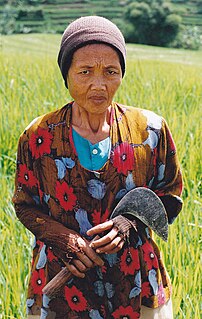
A Celurit or Clurit is generally a sickle with a pronounced crescent-blade patterns which curves more than half a circle and a long handle, is widely used for agricultural purposes and also in Pencak Silat. When compared to the Arit, the Celurit is slightly larger.
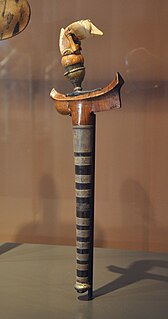
Listed here are the weapons of silat. The most common are the machete, staff, kris, sickle, spear, and kerambit. Because Southeast Asian society was traditionally based around agriculture, many of these weapons were originally farming tools.

The badik or badek is a knife or dagger developed by the Bugis and Makassar people of southern Sulawesi, Indonesia.

Wedung is a traditional large knife of the Javanese people and the Balinese people originating from Indonesia.

Gari is a sword that originates from Nias, an island off the west coast of North Sumatra, Indonesia. It is a term used for a type of sword found only in North Nias.
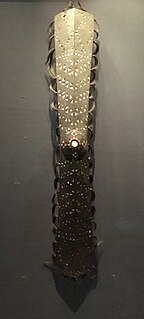
A Salawaku, is a traditional shield originating from the Maluku Islands, Indonesia. It is also known as Ma Dadatoko, Salwake, Saluwaku or Salawako in Galela, Salewaku-mu in Loloda, Hawau-mu in Madole, Emuli in Buru or O Dadatoko in Tobelo.
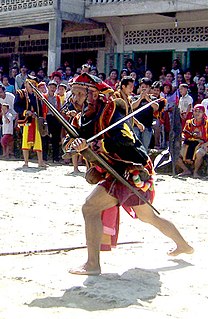
Indonesian martial arts includes a variety of fighting systems native to or developed in the archipelago of Indonesia, both the age-old traditional arts, and the more recently developed hybrid combatives. In the Indonesian language the term bela-diri is used to mean martial art, and in essence the Indonesian fighting arts are meant as one's defence against perceived threat and assault. Other than physical training, they often include spiritual aspects to cultivate inner strength, inner peace and higher psychological ends.

Bedil tombak or bedil tumbak is a type of early firearm from the Nusantara archipelago. The weapon consist of a gun or small cannon mounted on a wooden pole, forming a type of weapon known as "pole gun".

Music of Sunda also called Music of West Java, is an umbrella term that encompasses diverse musical traditions of the West Java and Banten in western part of Java, Indonesia. The term of "West Java" is preferred by scholars in this field. The word "Sunda" originally referred to western part of Java and has a strong association with the highly centralized Sunda Kingdom based on Java Island and its high culture practiced by the nobility and folk class in its capital Parahyangan. By contrast, scholars who cover a much broader region lay emphasis on Music of Java.






















